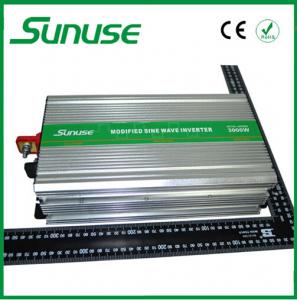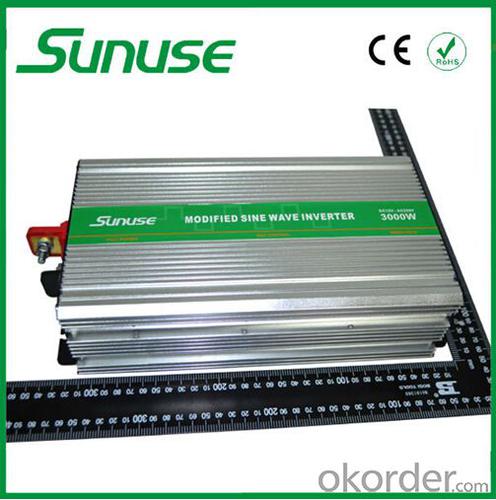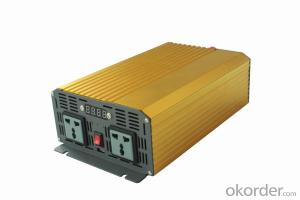Micro Solar Inverter Price:Solar Sine Wave Inverter 24V 230V 3000W DC to AC Inverter Supply for Power Pank
- Loading Port:
- China main port
- Payment Terms:
- TT or LC
- Min Order Qty:
- 15000 watt
- Supply Capability:
- 3000000 watt/month
OKorder Service Pledge
OKorder Financial Service
You Might Also Like
1. Structure of Solar Sine Wave Inverter 24v 230v 3000w Dc To Ac Inverter Supply For
Power Pank Description
A solar inverter, or PV inverter, or Solar converter, converts the variable direct current (DC) output of a photovoltaic (PV) solar panel into a
utility frequency alternating current (AC) that can be fed into a commercial electrical grid or used by a local, off-grid electrical network. It is a
critical BOS–component in a photovoltaic system, allowing the use of ordinary AC-powered equipment. Solar inverters have special
functions adapted for use with photovoltaic arrays, including maximum power point tracking and anti-islanding protection.
2. Main Features of Solar Sine Wave Inverter 24v 230v 3000w Dc To Ac Inverter Supply
For Power Pank
• High temperature protection:
Such as inverter internal temperature or ambient temperature is too high, machine will begin to open the high temperature protection
machine to stop working, and protect the safety of electrical equipment.
•Low voltage protection:
When the battery or power supply voltage is too low, the inverter will automatically shutdown protection, stop output in order to protect the
storage battery or power supply.When the voltage returns to normal, the inverter automatically return to work.
•High voltage protection:
When the battery or power supply voltage is too high, the inverter will automatically shutdown protection, stop output in order to protect the
storage battery or power supply.When the voltage returns to normal, the inverter automatically return to work.
•Overload protection:
When the connection of the loaded beyond the rated power of the inverter, the inverter will automatically be turned off to stop the output
.After removal of overload, automatically return to normal work.
•Short circuit protection:
When there is serious fault connected load, the inverter will automatically shutdown stop output, after removal of short circuit, automatic back
to normal work.
3. Power Inverter with Solar Sine Wave Inverter 24v 230v 3000w Dc To Ac Inverter
Supply For Power Pank Images
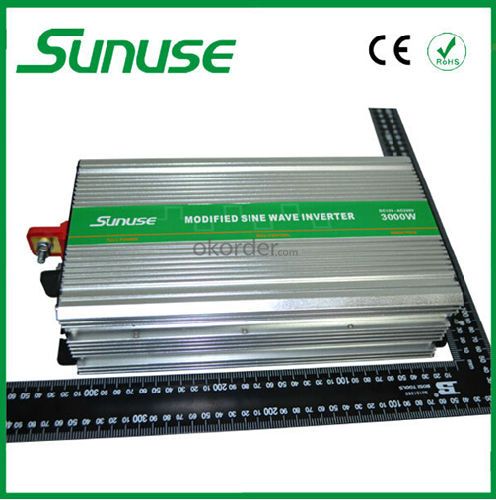
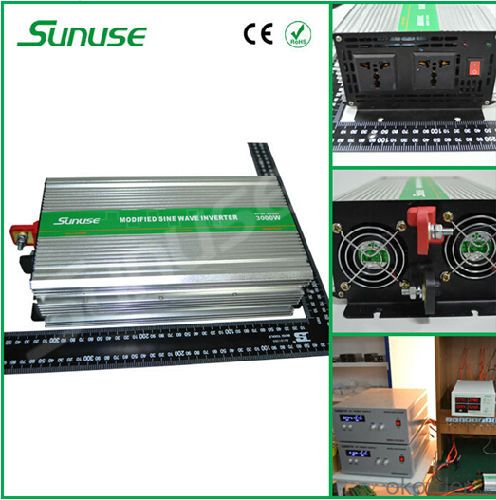

4. Solar Sine Wave Inverter 24v 230v 3000w Dc To Ac Inverter Supply For Power Pank
Specification
Item: | 3000W 12V | 3000W 24V | 3000W 48V |
Input DC Voltage Range: | 11-16V DC | 22-32V DC | 44-62V DC |
Under-voltage Protective: | 10.0±0.3V DC | 20.0±0.8V DC | 40.0±1.5V DC |
Under-voltage Alarm: | 10.5±0.3V DC | 21.0±0.8V DC | 42.0±1.5V DC |
Over Voltage Protective: | 16.0±0.3V DC | 31.0±0.8V DC | 62.0±1.5V DC |
Over Voltage Recovery: | 15.0±0.3V DC | 29.0±0.8V DC | 59.0±1.5V DC |
Max Power: | 3000W Modified sine wave inverter ac220v | ||
Peak Power: | 6000W | ||
Package: | White box package | ||
USB: | 2000mA | ||
Reverse Protecion: | Blown fuses | ||
Over Load Protection Power: | 110%-120% | ||
Quiescent Current: | ≤0.1A~0.6A | ||
Max. Efficiency: | ≥92% | ||
Total Harmonic Distortion: | ≤3% Linear load(modified sine wave) | ||
Short Circuit: | YES | ||
Status Indicator Lamp: | Work: Green LED Failure: Red LED and alarm | ||
LED Display: Voltage, Current, Power(optional) | |||
Work condition: | Operating Temperature: -10~40°C | ||
Opetating Humidity: 10--90%(non-condensate) | |||
5. FAQ of Solar Sine Wave Inverter 24v 230v 3000w Dc To Ac Inverter Supply For Power
Pank
Q1:Can we visit your factory?
A1:Sure,welcome at any time,seeing is believing.
Q2:Which payment terms can you accept?
A2:T/T,L/C,Moneygram,Paypal are available for us.
- Q: How does a solar inverter handle variations in battery charge levels?
- A solar inverter manages variations in battery charge levels by continuously monitoring the battery voltage and adjusting the charging and discharging rates accordingly. It optimizes the power flow and ensures that the battery is neither overcharged nor depleted, thus maximizing its lifespan and efficiency.
- Q: Can a solar inverter be used with different solar panel types?
- Solar inverters are capable of being utilized with various types of solar panels. Their purpose is to convert the direct current generated by solar panels into alternating current, which is suitable for powering household appliances and injecting into the electrical grid. So long as the solar panels produce compatible levels of DC voltage and current, they can be connected to the solar inverter. Various solar panel types, such as monocrystalline, polycrystalline, and thin-film, may possess different electrical characteristics. However, modern solar inverters are typically equipped with advanced electronics that can adapt to these discrepancies. Nevertheless, it is crucial to ensure the solar inverter is appropriately matched with the solar panel specifications in order to achieve optimal performance and efficiency.
- Q: Can a solar inverter be integrated with energy management systems?
- Yes, a solar inverter can be integrated with energy management systems. In fact, many modern solar inverters are designed to be compatible with energy management systems, allowing for better monitoring, control, and optimization of the energy generated by the solar panels. This integration enables users to track their energy production, consumption, and storage, and make informed decisions on energy usage to maximize efficiency and cost savings.
- Q: What is the maximum AC voltage that a solar inverter can provide?
- The maximum AC voltage that a solar inverter can provide typically depends on the specific model and its specifications. However, in general, most solar inverters are designed to produce a maximum AC voltage of around 240 volts in residential installations and up to 480 volts in commercial or utility-scale installations.
- Q: How does a solar inverter handle reactive power compensation?
- A solar inverter handles reactive power compensation by integrating power factor correction techniques. It actively monitors the power factor of the connected load and adjusts the reactive power flow accordingly. This ensures that the inverter delivers a balanced combination of active (real) power and reactive power, resulting in improved system efficiency and reduced power losses.
- Q: Can a solar inverter be used with solar-powered remote sensing systems?
- Yes, a solar inverter can be used with solar-powered remote sensing systems. A solar inverter is responsible for converting the direct current (DC) generated by solar panels into alternating current (AC) that can be used to power various devices and systems. In the case of solar-powered remote sensing systems, the solar inverter would be an essential component in converting the DC power from the solar panels into the required AC power to operate the remote sensing equipment.
- Q: What is the role of a power control feature in a solar inverter?
- The role of a power control feature in a solar inverter is to regulate and optimize the flow of electricity from the solar panels to the electrical grid or to the connected devices. It ensures that the power generated by the solar panels is converted and delivered efficiently, while also monitoring the voltage and frequency levels to maintain a stable and reliable power supply. Additionally, the power control feature enables the inverter to synchronize with the grid and comply with local regulations and requirements.
- Q: How is a solar inverter different from a regular inverter?
- A solar inverter converts the direct current (DC) generated by solar panels into alternating current (AC) to be used in homes or fed back into the electric grid. In contrast, a regular inverter is typically used to convert DC power from batteries or other sources into AC power for general electrical use. The main difference lies in their purpose and the source of the DC power they convert.
- Q: Can a solar inverter be installed indoors?
- Yes, a solar inverter can be installed indoors.
- Q: What is the maximum efficiency rating of a solar inverter?
- The maximum efficiency rating of a solar inverter can vary depending on the specific model and technology used, but generally, the highest efficiency ratings can range from 95% to 99%.
Send your message to us
Micro Solar Inverter Price:Solar Sine Wave Inverter 24V 230V 3000W DC to AC Inverter Supply for Power Pank
- Loading Port:
- China main port
- Payment Terms:
- TT or LC
- Min Order Qty:
- 15000 watt
- Supply Capability:
- 3000000 watt/month
OKorder Service Pledge
OKorder Financial Service
Similar products
Hot products
Hot Searches
Related keywords
